

If you thought I was a NCAA junkie before, you’ve now got more ammunition than you will ever need.
A few weeks ago, I wrote and article citing tips to defeat human opponents. Within my ramblings, I proposed the idea of running through your entire playbook in practice mode against different defenses in the hopes of developing a keen sense of awareness with as many plays as possible. The more familiar you are with your playbooks and how plays are countered by various defenses, the more dangerous you will become as an opponent.
At face value, such an activity seems mind-numbing, and stupendously un-fun. Still, there is tremendous benefit to it, despite the jeers you may take from your girlfriend. Trust me, she’ll get over it.
To effectively put my money where my mouth is, I decided to partake in such a study, and list some of my findings with you in a three-part article this week.
Some Notes Before I Get Started:
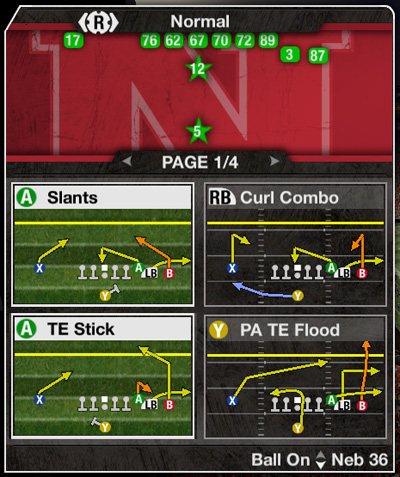 The playbook I used for my “experiment” was the Nebraska Cornhuskers. The reason? They were the team I drew in my upcoming Big 12 dynasty with some college buddies. So why not mix a little business with pleasure.
The playbook I used for my “experiment” was the Nebraska Cornhuskers. The reason? They were the team I drew in my upcoming Big 12 dynasty with some college buddies. So why not mix a little business with pleasure.
The plays in this portion of the study come from a formation called Ace Twin TE. I ran each of these passing plays against a 4-3 defense, as typically this is the type off defense that will oppose such a formation. I ran against the 4-3 Under Cover 2, 4-3 Normal Cover 3, and 4-3 Normal Free Fire.
The zone coverages are pretty basic and self-explanatory. Free Fire is a blitz play in which the right outside linebacker and middle linebacker blitz, while the rest of the defense sits in man coverage without any over-the-top safety help.
I picked these schemes mainly because they are representative of what many human opponents rely on defensively. In my NCAA Football tenure, I have played many games against human opponents, and noticed their defensive called tend to be simple and repetitive, so these three plays make the basis of a go study.
Also, to avoid confusion I will refer to the second TE in this formation as the H-Back. Sure, he is not a true H-Back in the Joe Gibbs sense, but it will keep things understandable.
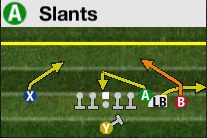
Slants vs. Cover 2
First Read - Split End: The split end tends to find a soft spot in the zone against the Cover 2. Make certain you time your throw correctly, before the throwing lane is obstructed by the middle linebacker
Second Read - Flanker: If for some reason you feel uneasy about the first read, glance over at the flanker, running a nearly identical pattern on the right hand side. The defense is slightly different on this side due to formation, so the flanker has a more difficult time finding space.
Third Read - Tight End: If you still feel uncomfortable with the WR routes, or if you wait too long, check down to the TE, who finds a nice spot beneath the linebackers. It will not get you a big gain, but a solid 3- or 4-yard gain is a distinct possibility, and a better alternative than taking a sack.
-Additional Notes: Avoid the H-back in the right flat like the plague. The outside corner will have a great lane for a pick six, should you errantly throw the ball in his direction.
Slants vs. Cover 3
First Read - Tight End: Your TE is almost instantly open here, with a decent amount of room to run. The rotation of the coverage leaves a nice lane for yards after the catch, and 5-to-10-yard gains are not uncommon.
Second Read - Flanker: The flanker is also open fairly quickly underneath the corner in the deep third, but covered before he reaches the middle of the field -- guarded closely by the roaming backer and safety. He will break free again after the TE, so make this your second read.
Third Read - H-Back: Not the greatest of check-down options here. Should you dawdle, the outside linebacker will creep over and occupy the outside flat zone. Still, I didn’t see many INTs on the check down, and you should get an opportunity to break a tackle and get some additional yardage.
-Additional Notes: Avoid the split end against the Cover 3. He is on an island on the left side and frequently gets triple teamed by the corner, OLB and safety.
Slants vs the Blitz (Free Fire)
All Reads: This play is tailor-made to exploit the blitz. I had repetitive success with all receivers against this play. The key is to be quick and decisive. If you are playing a human opponent, it is also a good idea to vary your throws. Good opponents will take note if you overly favor a certain receiver, and set you up for a double team.
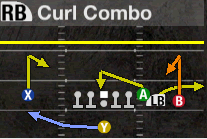
Curl Combo vs. Cover 2
First Read - Flanker: Although this zone is typically covered well by the Cover 2, the H-back leaking into the flat draws the attention of the corner, pulling him up and leaving a nice throwing lane for at least 8-yards. Make certain you throw the ball toward the outside shoulder, however. Tossing the rock inside leaves your throw vulnerable to an interception by the outside linebacker.
Second Read - Tight End: Just as in the previous play, the TE finds a nice vacancy beneath the linebackers -- a solid second option. He is often open immediately, so he also makes a good first read if you so choose.
Third Read - Halfback: The halfback’s delayed route is a solid last-ditch option. Although the flat is normally covered by the corner in the Cover 2, the delayed nature of the route causes the corner to move deeper to cover the Split End in on the curl route, leaving a vacancy close to the line of scrimmage.
-Additional Notes: Avoid the Split End here. Again, he is alone on an island on the left side of the field and becomes the primary focus of all defenders in the vicinity.
Curl Combo vs. Cover 3
First Read - Flanker: Amazingly enough, Curl Combo plays out in nearly identical fashion against both the Cover 2 and Cover 3 defenses. The flanker is your first read here, as he finds an even larger hole against this defense. No real need to throw your pass to the outside here, as there is a wide open throwing lane.
Second Read - Tight End: Once again, this little slant/curl route finds a sweet spot underneath the linebackers in zone coverage.
Third Read - Halfback: The delayed flat route is a perfect check-down here, as once again the Split End has captured the attention of all three zone defenders on the left side. The HB will have more space to maneuver here than he does against the Cover 2, making 5-to-7-yard gains a routine outcome.
-Additional Notes: Just as against the Cover 2, avoid the Split End, and avoid interceptions.
Curl Combos vs. Blitz (Free Fire)
First Read/Second Read - Split End/Flanker: Just like Slants, Curl Combo is a play designed to exploit man coverage and is most effective in a blitz situation. Either the Split End or Flanker are great options here. I’d lean toward whichever seems to have better separation.
Third Read - Halfback: If you can survive the blitz long enough, the halfback is almost the best option for this play. I don’t recommend making it your initial read just because it takes so long to develop. However, the delayed action of the route will hold the safety up momentarily, which often leaves the HB wide open when he completes his route. You will have ample space to put a juke on the safety as he struggles to recover.
-Additional Notes: The downside to this play is that there really is not great hot read if you are immediately under duress. The curl routes are not the fastest to develop, and the H-back is generally covered. If you are playing a skilled human opponent or lack good pocket presence, this play can fall victim to the blitz.
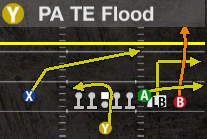
PA TE Flood vs. Cover 2
First Read - Flanker: I always recommend making a quick look deep on the play action. The flanker’s fly route should be your immediate first glance against any defense (with the exception of some heavy blitz plays). If it is not immediately obvious that the deep safety is fooled by the fake, look elsewhere.
Second Read - H-Back: Although your first look is deep downfield, your true primary read is the H-back on the deep out route. This route attacks one of the Cover 2’s three main vulnerabilities: the sideline between the corner (in the flat), and the safety (over the top). Although it is not a guarantee, this route should be open at least 90 percent of the time against the Cover 2.
Third Read - Tight End: Believe it or not, the TE in the flat is actually open against the Cover 2. The corner on the flanker side developed a nasty habit of partially following the flanker on the fly route, then scrambling back to cover the flat. The TE is usually open for a split second before the corner returns to his main responsibility.
-Additional Notes: The halfback is also a decent option, assuming he hasn’t been tackled off the fake. His out route to the opposite side of the field goes against the grain of the play’s natural action, and tends to give him room to move in the secondary.
PA TE Flood vs. Cover 3
First Read - Flanker: Once again, look deep first, even if it is just for a second. Just remember to not force the throw if it isn’t there.
Second Read - Split End: If the fly route is securely covered, look directly to the split end on the slant/post route. There will be a moment when he reaches a hole between the safety and the middle linebacker, when a tightly thrown spiral will almost always connect. Beware of a lurking linebacker waiting to decapitate your receiver.
Third Read - Tight End: The defense’s natural action will vacate the flats momentarily, leaving the TE wide open, and often resulting in a 10-yard gain. If you are feeling pressured quickly, make this the primary read. However, if you wait too long, the defense will adjust and close the throwing lane.
PA TE Flood vs. Blitz (Free Fire)
First Read - Flanker: Check the fly route deep. As many times as I ran this play, I only saw the corner bite on the fake maybe twice. Generally he will maintain solid position, but it is worth a quick glance.
Second Read - H-Back: Again, the H-back can be your real primary read on this play. Typically, the fake will freeze the outside linebacker, who is assigned to your H-back in man coverage. This will allow the H-back to get behind the linebacker on his route, and find some wide-open real estate on the deep out.
Third Read – Tight End: The fake has a favorable habit of delaying the safety’s movement into coverage, making the TE a great third option.
-Additional Notes: This play is less than ideal against a blitz play like Free Fire. It is really a toss up as to whether or not the defense buys the fake. If they do, the blitzing linebackers will follow the HB, giving you time to operate in or just outside the pocket. If they don’t buy it, your QB will eat turf. If you are anticipating a blitz, I would audible out.
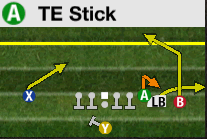
TE Stick vs. Cover 2
First Read – Flanker: Provided you are not facing a Tampa 2 scheme, this type of route is devastating to the Cover 2. The receiver will attack the deep middle of the field, behind the linebackers and between the two safeties. Make this your first read.
Second Read – Split End: If you wait long enough, the Split End will eventually make his way behind the linebackers, just underneath the flanker’s post route. If one of the safeties gets wise to the post, fire to the split end on the deep slant route.
Third Read – Tight End: Although he’s listed as the primary in the play-call screen, you would be a fool to zone in on the TE as your best option against the Cover 2. Still, he will be a decent third option sitting beneath the linebackers.
TE Stick vs. Cover 3
First Read – Flanker: Although the Cover 3 is designed to take away deep routes, still look to the flanker first. He will occasionally find some space between the deep corner and deep safety. A word of advice: throw high.
Second Read – H-Back: The H-back’s flat route is immediately open, as the linebacker will take a second or two to adjust over to the zone. It is a solid quick read to exploit one of the Cover 3's biggest weaknesses.
Third Read – Tight End: The shallow curl is always a good check down against a Cover 2 or 3. Not the most rewarding, but at least consistent.
-Additional Notes: Avoid the split end against the Cover 3 here. The safety will spy this route and take away the throwing lane.
TE Stick vs. Blitz (Free Fire)
First Read - Tight End: Often times against the blitz, your best read is a route that attacks an area of the field vacated by a blitzing defender. Against the blitz play Free Fire, the TE does exactly that. Make this your first look against the blitz.
Second Read - Split End: This is a relatively fast-developing route, and is a good second look against a man/blitz play. Provided the split end can achieve decent separation, he will be a good second read in your progression.
Third Read – H-Back: The flat is always a great place to look for your third option. On this play, however, it is risky. The longer you wait, the longer the safety will have to sneak up and cover the H-back. On short yardage against the blitz, I would actually make the H-back my primary option.
That's it for now, hope this helps all of you out. Look for Part 2 later this week!



